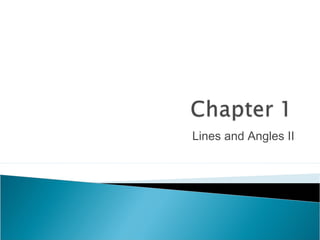
Chapter 1 Lines and Angles
- 1. Lines and Angles II
- 2. Parallel lines are straight lines that do not meet and remain at the same distance apart. Example: A B C D Line AB and CD are parallel lines.
- 3. A transversal is a straight line that intersects two or more parallel lines. Example: x A B C D y Line xy is a transversal.
- 4. Corresponding angles : Two angles that are located in the same relative location. If a transversal intersects two parallel lines, corresponding angles appear on the same side of the transversal. Example: Thus, the corresponding angles are d and f ; b and h; a and g; c and e. And; d=f; b=h; a = g; c=e
- 5. Alternate angles: Two angles, not adjoining one another, that are formed on opposite sides of a line that intersects two other lines. If the original two lines are parallel, the alternate angles are equal. Example: Thus, the alternate angles are: a and e; d and h; b and f; c and g And; a=e d=h b=f c=g
- 6. Interior angles: When two lines are cut by a transversal, the angles that are formed on the inside of the two lines are known as interior angles. Example : Thus, the interior angles are: d and e; f and c; a and h; b and g And; d + e = 180⁰ f + c = 180⁰ a + h = 180⁰ b + g = 180⁰
- 7. Interior angles: When two lines are cut by a transversal, the angles that are formed on the inside of the two lines are known as interior angles. Example : Thus, the interior angles are: d and e; f and c; a and h; b and g And; d + e = 180⁰ f + c = 180⁰ a + h = 180⁰ b + g = 180⁰
